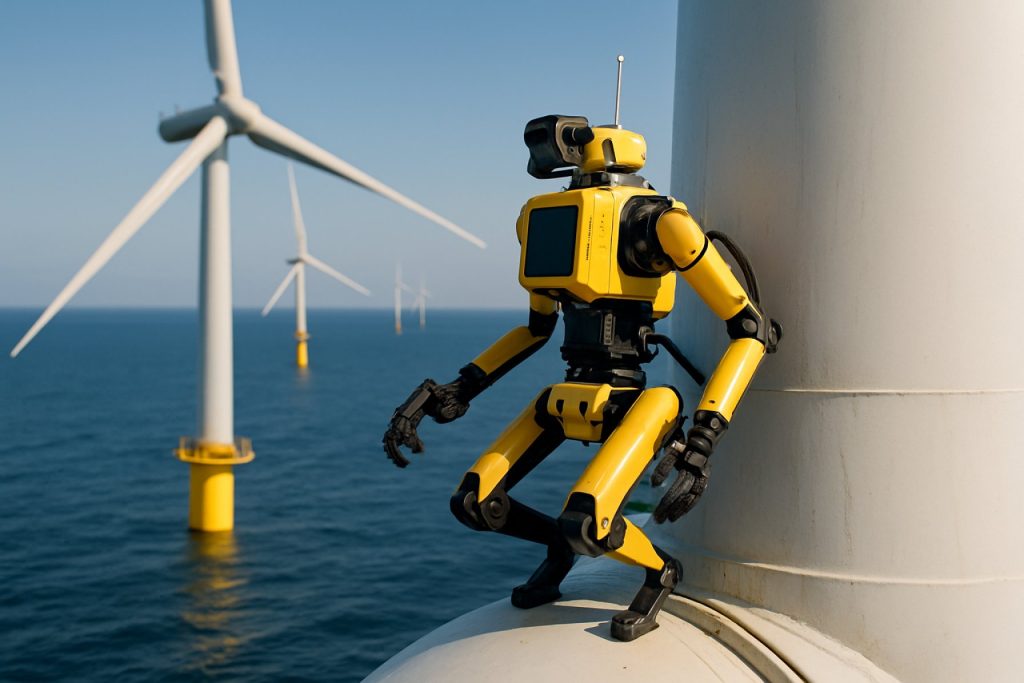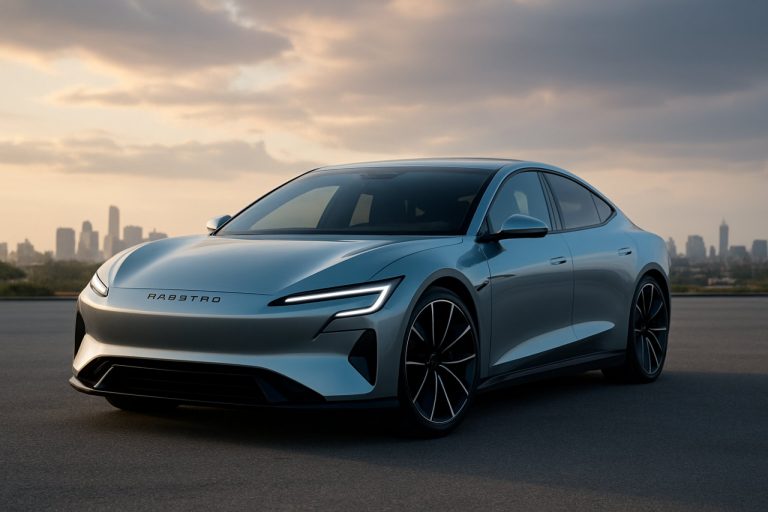
Offshore Windfarm Robotics Market Report 2025: Unveiling Growth Drivers, AI Innovations, and Global Opportunities. Explore Market Size, Key Players, and Strategic Forecasts for the Next 5 Years.
- Executive Summary & Market Overview
- Key Technology Trends in Offshore Windfarm Robotics
- Competitive Landscape and Leading Players
- Market Growth Forecasts (2025–2030): CAGR, Revenue, and Volume Analysis
- Regional Analysis: Europe, Asia-Pacific, North America, and Emerging Markets
- Future Outlook: Innovations, Investments, and Strategic Roadmaps
- Challenges and Opportunities: Regulatory, Technical, and Market Dynamics
- Sources & References
Executive Summary & Market Overview
The offshore windfarm robotics market is poised for significant growth in 2025, driven by the rapid expansion of offshore wind energy capacity and the increasing need for advanced automation solutions to enhance operational efficiency, safety, and cost-effectiveness. Offshore wind energy is a cornerstone of the global transition to renewable power, with cumulative installed capacity expected to surpass 100 GW by 2025, according to projections from the International Energy Agency (IEA). As windfarms move further offshore and into deeper waters, the complexity and cost of installation, inspection, maintenance, and repair (IMR) activities rise, creating a robust demand for robotics and autonomous systems.
Robotics in offshore wind encompasses a range of technologies, including remotely operated vehicles (ROVs), autonomous underwater vehicles (AUVs), aerial drones, and robotic manipulators. These systems are increasingly deployed for tasks such as blade inspection, subsea cable monitoring, foundation cleaning, and structural repairs, reducing the reliance on human intervention in hazardous environments. The adoption of robotics is further accelerated by labor shortages, stringent safety regulations, and the imperative to minimize turbine downtime and lifecycle costs.
Market analysts estimate that the global offshore windfarm robotics market will achieve a compound annual growth rate (CAGR) exceeding 20% through 2025, with Europe and Asia-Pacific leading in both installed wind capacity and robotics adoption. The United Kingdom, Germany, and China are at the forefront, supported by ambitious government targets and substantial investments in offshore wind infrastructure (Wood Mackenzie). Major industry players, including ABB, Siemens Energy, and specialized robotics firms such as Saab and Oceaneering International, are actively developing and deploying advanced robotic solutions tailored for offshore wind applications.
Key market drivers in 2025 include the scaling up of floating wind projects, the integration of artificial intelligence and machine learning for predictive maintenance, and the push for digitalization across the wind energy value chain. However, challenges remain, such as high upfront costs, integration with legacy systems, and the need for robust cybersecurity measures. Overall, the offshore windfarm robotics sector is set to play a pivotal role in enabling the next phase of offshore wind expansion, supporting the industry’s goals of sustainability, reliability, and cost reduction.
Key Technology Trends in Offshore Windfarm Robotics
The offshore windfarm robotics sector is experiencing rapid technological evolution in 2025, driven by the need to reduce operational costs, enhance safety, and improve efficiency in challenging marine environments. Several key technology trends are shaping the deployment and capabilities of robotics in offshore wind energy.
- Autonomous Inspection and Maintenance: Robotics equipped with advanced sensors and AI-driven navigation are increasingly used for autonomous inspection of turbine blades, foundations, and subsea cables. These systems, such as remotely operated vehicles (ROVs) and autonomous underwater vehicles (AUVs), can perform detailed visual and ultrasonic inspections, reducing the need for human intervention and minimizing downtime. According to DNV, the adoption of autonomous robotics is expected to cut inspection costs by up to 30% by 2025.
- Robotic Manipulation and Repair: The integration of dexterous manipulators and end-effectors enables robots to perform complex maintenance tasks, such as bolt tightening, cleaning, and minor repairs. Companies like ABB and Siemens Energy are developing robotic arms capable of operating in harsh offshore conditions, supporting both above-water and subsea applications.
- Swarm Robotics and Collaborative Systems: Swarm robotics, where multiple robots coordinate to perform large-scale inspections or maintenance, is gaining traction. This approach increases coverage and redundancy, allowing for faster and more reliable operations. Research from Fraunhofer Society highlights ongoing pilot projects using fleets of aerial and underwater drones for synchronized turbine inspections.
- AI and Data Analytics Integration: The fusion of robotics with AI and big data analytics is enabling predictive maintenance and real-time decision-making. Robots collect high-resolution data, which is analyzed to forecast component failures and optimize maintenance schedules. Wood Mackenzie reports that AI-driven robotics can extend turbine lifespans and reduce unplanned outages by up to 20%.
- Hybrid Power and Charging Solutions: To support longer missions, robotics are being equipped with hybrid power systems, including solar, wave, and battery technologies. Offshore charging stations and wireless power transfer are under development, as noted by Orcadian Energy, to enable continuous robotic operations without frequent retrieval.
These trends collectively signal a shift toward greater automation, intelligence, and resilience in offshore windfarm operations, positioning robotics as a cornerstone of the sector’s future growth.
Competitive Landscape and Leading Players
The competitive landscape of the offshore windfarm robotics market in 2025 is characterized by rapid technological innovation, strategic partnerships, and increasing investments from both established industrial players and specialized robotics firms. As offshore wind capacity expands globally, the demand for advanced robotics solutions—ranging from autonomous inspection drones to subsea maintenance robots—has intensified, driving competition among key market participants.
Leading players in this sector include ABB, Siemens Energy, and GE Renewable Energy, all of which leverage their extensive experience in automation and energy infrastructure to develop integrated robotic systems for windfarm operations. These conglomerates are increasingly collaborating with robotics specialists to accelerate the deployment of autonomous solutions for blade inspection, cable laying, and underwater maintenance.
Specialized robotics companies such as Saab Seaeye, Oceaneering International, and Fugro have established themselves as leaders in subsea robotics, offering remotely operated vehicles (ROVs) and autonomous underwater vehicles (AUVs) tailored for offshore wind applications. These firms are recognized for their advanced navigation, data acquisition, and manipulation capabilities, which are critical for the inspection and repair of submerged windfarm components.
Emerging players and startups are also making significant inroads, particularly in the field of aerial robotics and AI-driven analytics. Companies like Percepto and SkySpecs are deploying drone-based inspection platforms that utilize machine learning to detect blade defects and optimize maintenance schedules, reducing downtime and operational costs for windfarm operators.
- Strategic Alliances: The market is witnessing a surge in joint ventures and technology partnerships, such as the collaboration between Siemens Gamesa and ABB to integrate robotics and digitalization in offshore wind operations.
- Regional Dynamics: European companies dominate the market, driven by the region’s aggressive offshore wind targets and supportive regulatory frameworks. However, Asian and North American players are rapidly scaling up, with China and the U.S. investing heavily in domestic robotics capabilities.
- Innovation Focus: Key areas of competition include the development of fully autonomous inspection systems, AI-powered predictive maintenance, and modular robotics platforms adaptable to diverse offshore environments.
Overall, the offshore windfarm robotics market in 2025 is marked by a dynamic mix of established industrial giants, agile robotics specialists, and innovative startups, all vying for leadership in a sector poised for significant growth and technological transformation.
Market Growth Forecasts (2025–2030): CAGR, Revenue, and Volume Analysis
The offshore windfarm robotics market is poised for robust growth between 2025 and 2030, driven by the accelerating deployment of offshore wind energy projects and the increasing need for automation in operations and maintenance (O&M). According to projections by MarketsandMarkets, the global offshore wind market is expected to reach over $56 billion by 2027, with robotics playing a pivotal role in reducing costs and improving safety. Specifically, the offshore windfarm robotics segment—including autonomous inspection drones, remotely operated vehicles (ROVs), and robotic manipulators—is forecasted to achieve a compound annual growth rate (CAGR) of approximately 18–22% during the 2025–2030 period.
Revenue from offshore windfarm robotics is anticipated to surpass $2.5 billion by 2030, up from an estimated $900 million in 2025, as reported by IDTechEx. This surge is attributed to the scaling of offshore wind capacity, particularly in Europe, Asia-Pacific, and the United States, where governments are setting ambitious renewable energy targets. The volume of deployed robotic units—including aerial drones for blade inspection, underwater robots for foundation monitoring, and autonomous surface vessels for logistics—is expected to grow at a similar pace, with annual shipments projected to exceed 7,000 units by 2030.
- Europe: The region will remain the largest market, driven by the North Sea’s extensive windfarm projects and supportive regulatory frameworks. The UK, Germany, and the Netherlands are leading adopters of robotics for O&M, with the European market expected to account for over 45% of global revenue by 2030 (WindEurope).
- Asia-Pacific: China, Taiwan, and Japan are rapidly expanding their offshore wind capacity, fueling demand for robotics to address labor shortages and harsh marine conditions. The region’s CAGR is projected to outpace Europe, reaching up to 25% in some segments (Wood Mackenzie).
- North America: The U.S. offshore wind sector is emerging, with significant investments in robotics expected as large-scale projects come online post-2025 (National Renewable Energy Laboratory).
Overall, the offshore windfarm robotics market’s growth trajectory from 2025 to 2030 will be shaped by technological advancements, cost reduction imperatives, and the global push for clean energy, resulting in strong double-digit CAGR and substantial increases in both revenue and unit volume.
Regional Analysis: Europe, Asia-Pacific, North America, and Emerging Markets
The offshore windfarm robotics market is experiencing dynamic growth across key regions—Europe, Asia-Pacific, North America, and emerging markets—driven by the global push for renewable energy and the need to optimize offshore wind operations. Each region presents unique opportunities and challenges, shaping the adoption and innovation of robotics in offshore windfarms.
- Europe: Europe remains the global leader in offshore windfarm robotics, underpinned by ambitious renewable energy targets and mature offshore wind infrastructure. The United Kingdom, Germany, and the Netherlands are at the forefront, leveraging robotics for inspection, maintenance, and installation tasks to reduce operational costs and enhance safety. The European Union’s Green Deal and the UK’s commitment to 50 GW of offshore wind capacity by 2030 are accelerating investments in advanced robotics solutions. Companies such as ABB and Siemens are actively developing and deploying robotic systems tailored for harsh offshore environments.
- Asia-Pacific: The Asia-Pacific region, particularly China, Taiwan, and Japan, is rapidly expanding its offshore wind capacity, driving demand for robotics to address labor shortages and improve efficiency. China’s 14th Five-Year Plan emphasizes offshore wind, with the country surpassing 30 GW of installed capacity by 2025. Robotics are increasingly used for underwater inspections, cable laying, and blade maintenance. Local players and global technology providers, such as Hitachi and Mitsubishi Electric, are investing in R&D to adapt robotics to regional conditions, including typhoon resilience and deepwater operations.
- North America: North America, led by the United States, is in the early stages of offshore wind development but is poised for significant growth. The Biden administration’s target of 30 GW of offshore wind by 2030 is catalyzing investments in robotics for installation, monitoring, and maintenance. The region’s focus is on leveraging robotics to overcome workforce constraints and ensure the reliability of new offshore assets. Partnerships between U.S. energy firms and European robotics specialists, such as GE Renewable Energy, are fostering technology transfer and local adaptation.
- Emerging Markets: Emerging markets in Latin America, the Middle East, and Africa are beginning to explore offshore wind potential, with robotics seen as a means to leapfrog traditional maintenance challenges. While deployment is nascent, pilot projects in Brazil and South Africa are testing robotic solutions for cost-effective asset management, often in collaboration with international technology providers.
Overall, regional dynamics in 2025 reflect a convergence of policy support, technological innovation, and market demand, positioning offshore windfarm robotics as a critical enabler of global renewable energy expansion.
Future Outlook: Innovations, Investments, and Strategic Roadmaps
The future outlook for offshore windfarm robotics in 2025 is shaped by rapid technological innovation, increasing investment, and the strategic alignment of industry stakeholders. As offshore wind capacity expands globally, robotics are becoming central to addressing operational challenges, reducing costs, and enhancing safety. The integration of autonomous and semi-autonomous robots for inspection, maintenance, and repair is expected to accelerate, driven by both market demand and regulatory pressures for safer, more efficient operations.
Key innovations anticipated in 2025 include the deployment of advanced autonomous underwater vehicles (AUVs) and remotely operated vehicles (ROVs) equipped with AI-powered diagnostics and predictive maintenance capabilities. These systems are designed to perform complex tasks such as blade inspection, cable monitoring, and foundation cleaning with minimal human intervention. Companies like ABB and Boskalis are investing in next-generation robotics platforms that leverage machine learning and real-time data analytics to optimize maintenance schedules and reduce downtime.
Investment trends indicate a surge in funding for robotics startups and technology providers specializing in offshore wind applications. According to Wood Mackenzie, global investment in offshore wind operations and maintenance (O&M) robotics is projected to exceed $1.5 billion by 2025, reflecting a compound annual growth rate (CAGR) of over 20% from 2022. This influx of capital is fostering collaboration between windfarm operators, robotics manufacturers, and research institutions, accelerating the commercialization of innovative solutions.
Strategic roadmaps from leading offshore wind developers, such as Ørsted and Siemens Gamesa, emphasize the integration of robotics into their O&M strategies. These companies are piloting robotic systems for turbine blade repair and subsea infrastructure inspection, aiming to reduce reliance on costly and hazardous manual interventions. Additionally, industry-wide initiatives, such as the Offshore Renewable Energy (ORE) Catapult, are supporting the development and standardization of robotic technologies to ensure interoperability and scalability across diverse windfarm assets.
Looking ahead, the convergence of robotics, AI, and digital twin technologies is expected to redefine offshore windfarm management. By 2025, the sector will likely witness the emergence of fully autonomous robotic fleets capable of continuous monitoring and adaptive maintenance, setting new benchmarks for efficiency, safety, and sustainability in offshore wind energy.
Challenges and Opportunities: Regulatory, Technical, and Market Dynamics
The offshore windfarm robotics sector in 2025 is shaped by a complex interplay of regulatory, technical, and market dynamics, each presenting distinct challenges and opportunities for stakeholders.
Regulatory Challenges and Opportunities: The regulatory landscape for offshore windfarm robotics is evolving rapidly. Governments in Europe, Asia, and North America are tightening safety and environmental standards for offshore operations, which can increase compliance costs and slow project approvals. However, these regulations also create opportunities for robotics companies to develop solutions that enhance safety, reduce human intervention, and minimize environmental impact. For example, the European Union’s updated Renewable Energy Directive and the UK’s Offshore Wind Sector Deal are driving demand for advanced inspection and maintenance robotics that meet stringent operational standards (European Commission, UK Government).
Technical Challenges and Innovations: Offshore windfarms present harsh environments—high winds, saltwater corrosion, and limited accessibility—that challenge the reliability and autonomy of robotic systems. Key technical hurdles include robust navigation in turbulent waters, real-time data transmission, and the integration of AI for predictive maintenance. However, advances in subsea robotics, edge computing, and sensor fusion are enabling more resilient and intelligent robots. Companies like Saab and Oceaneering International are deploying remotely operated vehicles (ROVs) and autonomous underwater vehicles (AUVs) tailored for windfarm inspection and repair, reducing downtime and operational costs.
- Emerging standards for interoperability and cybersecurity are fostering a more competitive ecosystem, but also require ongoing investment in compliance and system upgrades.
- Collaborative robotics (cobots) and swarm robotics are being piloted to handle complex tasks such as blade cleaning and subsea cable inspection, offering scalability and redundancy.
Market Dynamics: The global offshore wind market is projected to reach over 250 GW of installed capacity by 2030, with robotics playing a pivotal role in scaling operations (International Renewable Energy Agency). The growing focus on lifecycle cost reduction and asset optimization is accelerating investment in robotics startups and partnerships between windfarm operators and technology providers. However, high upfront costs and the need for specialized workforce training remain barriers to widespread adoption.
In summary, while regulatory and technical complexities persist, the offshore windfarm robotics sector in 2025 is poised for significant growth, driven by innovation, supportive policy frameworks, and the imperative to enhance operational efficiency in a rapidly expanding market.
Sources & References
- International Energy Agency (IEA)
- Wood Mackenzie
- ABB
- Siemens Energy
- Saab
- Oceaneering International
- DNV
- Fraunhofer Society
- GE Renewable Energy
- Fugro
- Percepto
- SkySpecs
- Siemens Gamesa
- MarketsandMarkets
- IDTechEx
- National Renewable Energy Laboratory
- Siemens
- Hitachi
- Mitsubishi Electric
- Offshore Renewable Energy (ORE) Catapult
- European Commission
- UK Government



